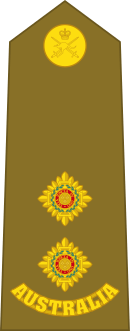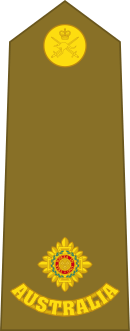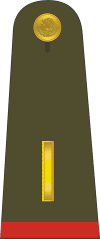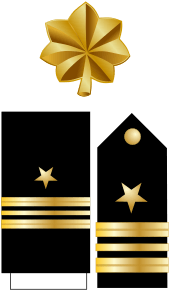Lieutenant
A lieutenant (UK: /lɛfˈtɛnənt/ lef-TEN-ənt or US: /luːˈtɛnənt/ loo-TEN-ənt[1] abbreviated Lt., Lt, LT, Lieut and similar) is the second junior-most or in some cases the junior-most commissioned officer in the armed forces, fire services, police, and other organizations of many nations.
The meaning of lieutenant differs in different militaries (see comparative military ranks), but is often subdivided into senior (first lieutenant) and junior (second lieutenant and even third lieutenant) ranks. In navies it is often equivalent to the army rank of captain; it may also indicate a particular post rather than a rank. The rank is also used in fire services, emergency medical services, security services and police forces.
Lieutenant may also appear as part of a title used in various other organisations with a codified command structure. It often designates someone who is "second-in-command", and as such, may precede the name of the rank directly above it. For example, a "lieutenant master" is likely to be second-in-command to the "master" in an organisation using both ranks.
Political uses include lieutenant governor in various governments, and Quebec lieutenant in Canadian politics. In the United Kingdom, a lord lieutenant is the sovereign's representative in a county or lieutenancy area, while a deputy lieutenant is one of the lord lieutenant's deputies.
Etymology
The word lieutenant derives from French; the lieu meaning "place" as in a position (cf. in lieu of); and tenant meaning "holding" as in "holding a position"; thus a "lieutenant" is a placeholder for a superior, during their absence (compare the Latin locum tenens).
In the 19th century, British writers who considered this word either an imposition on the English language, or difficult for common soldiers and sailors, argued for it to be replaced by the calque "steadholder". However, their efforts failed, and the French word is still used, along with its many variations (e.g. lieutenant colonel, lieutenant general, lieutenant commander, flight lieutenant, second lieutenant and many non-English language examples), in both the Old and the New World.
Pronunciation
Pronunciation of lieutenant is generally split between the forms /lɛfˈtɛnənt/ (![]()
![]()
The rare Old French variant spelling luef for Modern French lieu ('place') supports the suggestion that a final [u] of the Old French word was in certain environments perceived as an [f].[3] Furthermore, in Latin, the lingua franca of the era, the letter v is used for both u and v.
In Royal Naval tradition—and other English-speaking navies outside the United States—a reduced pronunciation /ləˈtɛnənt/ (![]()
Army ranks
Conventionally, armies and other services or branches that use army-style rank titles have two grades of lieutenant, but a few also use a third, more junior, rank. Historically the "lieutenant" was the deputy to a "captain", and as the rank structure of armies began to formalise, this came to mean that a captain commanded a company and had several lieutenants, each commanding a platoon. Where more junior officers were employed as deputies to the lieutenant, they went by many names, including second lieutenant, sub-lieutenant, ensign and cornet. Some parts of the British Army, including the Royal Artillery, Royal Engineers and fusilier regiments, used first lieutenant as well as second lieutenant until the end of the 19th century, and some British Army regiments still preserve cornet as an official alternative to second lieutenant.
Lieutenant
The senior grade of lieutenant is known as first lieutenant in the United States, and as lieutenant in the United Kingdom and the rest of the English-speaking world. In countries that do not speak English, the rank title usually translates as "lieutenant", but may also translate as "first lieutenant" or "senior lieutenant". The Israel Defense Forces rank segen (סגן) literally translates as "deputy", which is equivalent to a lieutenant. In the Finnish military there is a senior lieutenant grade that ranks above lieutenant and second lieutenant but below captain; it does not have an English equivalent. In Germany it is called Oberleutnant (high-lieutenant).
There is great variation in the insignia used worldwide. In most English-speaking and Arabic-speaking countries, as well as a number of European and South American nations, full lieutenants (and equivalents) usually wear two stars (pips) and second lieutenants (and equivalents) one. An example of an exception is the United States, whose armed forces distinguish their lieutenant ranks with one silver bar for first lieutenant and one gold (brass) bar for second lieutenant.

Australia 
Bangladesh 
Bosnia and Herzegovina 
Brazil
(Primeiro Tenente)-2014.svg.png) Canada
Canada French ONF
French ONF France
France Georgia
Georgia Germany
Germany Greece
Greece India
India Indonesia
Indonesia Iran
Iran Ireland
Ireland Israel
Israel.svg.png) Italy
Italy.svg.png) Japan (JASDF)
Japan (JASDF) Korea, North (Navy, senior lieutenant)
Korea, North (Navy, senior lieutenant) Korea, South (Marine)
Korea, South (Marine) North Macedonia
North Macedonia Mexico
Mexico Poland
Poland_Pakistan_Army.svg.png) Pakistan
Pakistan Romania
Romania Russia (senior lieutenant)
Russia (senior lieutenant) South Africa
South Africa Sweden
Sweden.svg.png) Thailand
Thailand United Kingdom
United Kingdom United States
United States
Second lieutenant
Second lieutenant is usually the most junior grade of commissioned officer. In most cases, newly commissioned officers do not remain at the rank for long before being promoted, and both university graduates and officers commissioned from the ranks may skip the rank altogether. In non-English-speaking countries, the equivalent rank title may translate as "second lieutenant", "lieutenant", "sub-lieutenant" or "junior lieutenant". Non-English terms include alferes (Portuguese Army and Air Force), alférez (Spanish Army and Air Force), fänrik (Swedish Armed Forces), ensign, Leutnant (German Army), letnan (Indonesian National Armed Forces), poručík (Czech Army), segen mishne (Israel Defense Forces) or løjtnant (Danish Army).

Australia 
Bangladesh 
Bosnia and Herzegovina 
Brazil
(Segundo Tenente)-2014.svg.png) Canada
Canada France
France Georgia
Georgia Germany
Germany Greece
Greece Indonesia
Indonesia Iran
Iran Ireland
Ireland Israel
Israel.svg.png) Italy
Italy.svg.png) Japan (JGSDF)
Japan (JGSDF) Korea, North (Army)
Korea, North (Army)- Korea, South (Air Force)
 North Macedonia
North Macedonia Mexico
Mexico Poland
Poland_Pakistan_Army.svg.png) Pakistan
Pakistan Romania
Romania South Africa
South Africa Sweden
Sweden.svg.png) Thailand
Thailand United Kingdom
United Kingdom United States
United States
Third lieutenant
Eastern European ranks
A few non-English-speaking militaries maintain a lower rank, frequently translated as "third lieutenant" OF1c. The rank title may actually translate as "second lieutenant", "junior lieutenant", "sub-lieutenant" or "ensign". Warsaw Pact countries (except Poland since 1957) standardised their ranking systems on the Soviet system. Some of the former Soviet and Warsaw Pact nations have now discarded the third rank while many retain it like Ukraine, Georgia and Armenia. Other nations use the term "senior poruchik" or "nadporuchik" (OF1a), "poruchik" (OF1b), and "junior poruchik" or "podporuchik" (OF1c).
Russia
The Soviet Union used the three ranks senior lieutenant (старший лейтенант; starshy leytenant - OF1a), lieutenant (лейтенант; leytenant - OF1b), and junior lieutenant (мла́дший лейтенант; mladshy leytenant - OF1c). The armed forces of the Russian Federation inherited this rank structure. If military personnel serve in a guards formation, or on a guards warship, the rank designation will be preceded by the word "guards" (e.g. "guards junior lieutenant"). For civil or military personnel in the medical or judicial professions, the military rank will be preceded by the words "legal" or "medical service".
| gorget patch (1935 – 1940/43) | Army shoulder straps | ||||||||
| Army | Armoured troops |
Air Force | (1946–1955) | (1955–1994) | (until 2010) | (since 1994) | (since 1994) | (since 1994) | |
United States ranks
In March 1813 the US Army created the rank of third lieutenant. The rank was used as the entry level officer rank for the Ordnance Department and the Corps of Artillery until March 1821.[5] Throughout the 19th century and until as late as World War II[6] the United States Army sometimes referred to brevet second lieutenants as "third lieutenants". These were typically newly commissioned officers for which no authorized second lieutenant position existed. Additionally, the Confederate States Army also used "third lieutenant", typically as the lowest ranking commissioned officer in an infantry company.
Notably the United States Revenue Cutter Service used a simple officer rank structure with Captain, First, Second and Third Lieutenants, each of whom had distinct insignia. The title of Third Lieutenant, essentially equal to the rank of ensign, existed until 1915 when the Service became the nucleus of the new United States Coast Guard.[7] Because of the time required to fully establish this organization the rank continued for some time afterwards; the first Coast Guard aviator, Elmer F. Stone, was a third lieutenant until 1918.[8]
Naval rank
| Naval officer ranks |
|---|
| Flag officers |
| Senior officers |
| Junior officers |
Lieutenant commander
Lieutenants were commonly put in command of smaller vessels not warranting a commander or captain: such a lieutenant was called a "lieutenant commanding" or "lieutenant commandant" in the United States Navy, and a "lieutenant in command" or "lieutenant and commander" in the Royal Navy. The USN settled on "lieutenant commander" in 1862, and made it a distinct rank; the Royal Navy followed suit in March 1914. The insignia of an additional half-thickness stripe between the two full stripes of a lieutenant was introduced in 1877 for a Royal Navy lieutenant of 8 years seniority, and used for lieutenant commanders upon introduction of their rank.[9]
 Greece
Greece Portugal
Portugal US
US
Lieutenant
During the early days of the naval rank, a lieutenant might be very junior indeed, or might be on the cusp of promotion to captain; by modern standards he might rank with any army rank between second lieutenant and lieutenant colonel. As the rank structure of navies stabilized, and the ranks of commander, lieutenant commander and sub-lieutenant were introduced, the naval lieutenant came to rank with an army captain (NATO OF-2 or US O-3).
The insignia of a lieutenant in many navies, including the Royal Navy,[10] consists of two medium gold braid stripes (top stripe with loop) on a navy blue or black background. This pattern was copied by the United States Navy and various Air Forces for their equivalent ranks grades, except that the loop is removed (see flight lieutenant).
 France
France Greece
Greece India
India Portugal
Portugal US
US
"First lieutenant" in naval use
The first lieutenant in the Royal Navy and other Commonwealth navies, is a post or appointment, rather than a rank. Historically the lieutenants in a ship were ranked in accordance with seniority, with the most senior being termed the "first lieutenant" and acting as the second-in-command. Although lieutenants are no longer numbered by seniority, the post of "first lieutenant" remains. In minor war vessels, destroyers and frigates the first lieutenant (either a lieutenant or lieutenant-commander) is second in command, executive officer (XO) and head of the executive branch; in larger ships where a commander of the warfare specialization is appointed as the executive officer, a first lieutenant (normally a lieutenant-commander) is appointed as his deputy. The post of first lieutenant in a shore establishment carries a similar responsibility to the first lieutenant of a capital ship.
In the U.S. Navy or U.S. Coast Guard the billet of first lieutenant describes the officer in charge of the deck department or division, depending upon the size of the ship. In smaller ships with only a single deck division, the billet is typically filled by an ensign while in larger ships with a deck department, consisting of multiple subordinate divisions, the billet may be filled by a lieutenant commander. On submarines and smaller Coast Guard cutters the billet of first lieutenant may be filled by a petty officer.
Sub-lieutenant
In the Royal Navy the commissioned rank of mate was created in 1840, and was renamed sub-lieutenant in 1860. In the US Navy the rank was called master until 1883, when it was renamed lieutenant, junior grade. In many navies, a sub-lieutenant is a naval commissioned or subordinate officer, ranking below a lieutenant, but in Brazil it is the highest non-commissioned rank, and in Spain it is the second highest non-commissioned rank. In Portugal, sub-lieutenant is the rank of a junior naval officer graduated from a civil university or promoted from a NCO rank, while the equivalent rank of an officer graduated in the naval academy is designated midshipman.
 Canada
Canada India
India Portugal
Portugal UK
UK
Marine rank
The United States Marine Corps and British Royal Marines[11] both use army ranks, while many former Eastern-Bloc marine forces retain the naval form. Before 1999 the Royal Marines enjoyed the same rank structure as the army, but at a grade higher; thus a Royal Marine captain ranked with and was paid the same as a British Army major. This historical remnant caused increasing confusion in multi-national operations and was abolished.
Air force rank
While some air forces use the army rank system, the British Royal Air Force and many other Commonwealth air forces use another rank system in which flight lieutenant ranks with an army captain and naval lieutenant, a flying officer ranks with an army lieutenant and a pilot officer with an army second lieutenant.
| NATO OF-2 / US O-3 | |||||||||
|---|---|---|---|---|---|---|---|---|---|
 |
 |
||||||||
| Australian Flight lieutenant |
Indian Flight lieutenant |
Thai Flight lieutenant |
UK Flight lieutenant | ||||||
| NATO OF-1a / US O-2 | |||||||||
-2015.svg.png) |
 |
||||||||
| Brazil Primeiro Tenente |
Canada Lieutenant |
Germany Oberleutnant |
Mexico Teniente |
Poland Porucznik |
Romania Locotenent |
South Africa Lieutenant |
Spain Teniente |
Sweden Löjtnant |
US First Lieutenant |
| NATO OF-1b / US O-1 | |||||||||
-2015.svg.png) |
 |
||||||||
| Brazil Segundo Tenente |
Canada Second lieutenant |
Germany Leutnant |
Mexico Subteniente |
Poland Podporucznik |
Romania Sublocotenent |
South Africa Second Lieutenant |
Spain Alférez |
Sweden Fänrik |
US Second lieutenant |
In the US Air Force, the Third Lieutenant Program refers specifically to a training program at active duty air force bases for cadets of the Air Force Academy and Air Force ROTC the summer before their fourth and final year before graduation and commissioning. A single silver or subdued pip is used to designate this rank.
The Royal Air Force also has an acting pilot officer designation, the most junior commissioned rank in the British armed forces. It is functionally equivalent to third lieutenant (OF-1c / O-0).
Police rank
France and the French Union
The first French Lieutenant of Police, Gabriel Nicolas de la Reynie, was appointed in Paris by Louis XIV on 15 March 1967 to command a reformed police force. He was later elevated to Lieutenant-General of Police. In the 17th century, the term "lieutenant" corresponded to "deputy" (i.e. a person appointed to carry out a task). La Reynie was the deputy for policing duties of the Provost of Paris, the ceremonial representative of the King in Paris. In 1995, the rank of lieutenant was introduced in the National Police as the first rank of the police officers scale.
United Kingdom and Commonwealth police forces
The rank of Lieutenant was formerly used in areas outside of the Metropolitan Police. The adoption of standardized ranks across the United Kingdom has eliminated its use. A number of city and burgh police forces in Scotland used the rank of lieutenant (and detective lieutenant) between inspector and superintendent from 1812 to 1948. It was replaced by the rank of chief inspector.[12] The Royal Newfoundland Constabulary (founded 1871) had the rank of lieutenant between staff sergeant and inspector until 1997. In Australia, Queensland's first police force (founded 1864) had second lieutenants and lieutenants between the ranks of sergeant and inspector-general.
United States police forces
The rank of police lieutenant is used in most medium or large police departments in the United States, where it is one rank above sergeant and two ranks above a regular police officer (three in departments with a corporal rank). It is roughly equivalent to an inspector in British police forces and staff sergeant in Canadian police forces. The usual role of a lieutenant is to carry out administrative duties and assist precinct commanders (normally a Captain, or sometimes the local police chiefs). In smaller police departments they may command a precinct itself. Lieutenants either command a watch (8-hour "shift") of regular officers or a special unit for operations or investigations (like a Robbery-Homicide squad). The typical rank insignia for a lieutenant is a single silver bar (like that of an Army or Marine Corps First Lieutenant) or a single gold bar (like that of an Army or Marine Corps Second Lieutenant). Some police departments split the rank of lieutenant into two separate grades.
Other Nations
 |
 |
||||||
| Brazilian Military Police 2nd Lieutenant |
Brazilian Military Police 1st Lieutenant |
Indian Assistant Superintendent |
Polish Policja Komisarz |
Romanian Inspector |
US Police 2nd Lieutenant |
US Police 1st Lieutenant |
Russian Police Lieutenant |
Fire services rank
Singapore
In the Singapore Civil Defence Force, the rank of lieutenant (LTA) is the second-lowest commissioned rank. The rank insignia of LTA is two pips.[13]
Other uses
Countries
The British monarch's representatives in the counties of the United Kingdom are called Lords Lieutenant. The Lord Lieutenant of Ireland performed the function of viceroy in Ireland. In French history, "lieutenant du roi" was a title borne by the officer sent with military powers to represent the king in certain provinces. It is in the sense of a deputy that it has entered into the titles of more senior officers, lieutenant general and lieutenant colonel. In Canada the representative of the Canadian monarch in each of the Canadian provinces is called the Lieutenant Governor. The Lieutenant Governor exercises all the royal prerogative powers that the monarch holds.
The Salvation Army
The Salvation Army also uses lieutenant to denote first time officers, or clergymen/women.
The Boys' Brigade
Leaders, or officers of the Boys' Brigade, particularly in the United Kingdom, are ranked as lieutenants after having completed their formal training, before which they are ranked as warrant officers. Officers serving in staff or command posts are awarded the "brevet" rank of captain, these officers then revert to their lieutenancy after having completed their tour of duty.
National Civil Defence Cadet Corps
The rank of cadet lieutenant (CLT) is given to officer cadet trainees who have passed their officer's course. The rank insignia of CLT is a pip and a bar below it. CLTs may be promoted to the rank of senior cadet lieutenant (S/CLT), which has a rank insignia of a pip and two bars below it.[14]
See also
- Captain lieutenant
- Military rank
- Comparative military ranks
References
- Wells, John (3 April 2008). Longman Pronunciation Dictionary (3rd ed.). Pearson Longman. ISBN 978-1-4058-8118-0.
- American Heritage Dictionary, s.v. "Lieutenant" Archived 2007-10-12 at the Wayback Machine
- Oxford English Dictionary.
- Dobson, E. J. (1968) [1957]. English Pronunciation 1500-1700. ii (second ed.). Oxford: Clarendon Press. p. 1009.
- p.970 Tucker, Spencer C. The Encyclopedia Of the War Of 1812: A Political, Social, and Military History [3 volumes] ABC-CLIO, 25 Apr 2012
- "Full Text Citations For Award of The Distinguished Service Cross". Retrieved 27 July 2009.
The President of the United States takes pride in presenting the Distinguished Service Cross (Posthumously) to Baltazar Adona, Third Lieutenant, U.S. Army, for conspicuous gallantry and intrepidity in action against a hostile force in the Philippine Islands. Third Lieutenant Adona distinguished himself by intrepid actions from 10 to 16 December 1941 while serving with the Philippine Scouts
- "United States Revenue Marine Uniforms & Devices to 1908" (PDF).
- Commander Elmer F. "Archie" Stone, USCG Coast Guard Aviator #1
- "Officer Ranks in the Royal Navy – Lieutenant Commander". Royal Naval Museum. Archived from the original on 2014-10-11. Retrieved 2008-10-11.
- "Uniforms and Badges of Rank – Royal Navy website". Archived from the original on 2008-10-12. Retrieved 2008-10-05.
- "RM Officers & Other Ranks Badges of Rank – Royal Navy website". Archived from the original on 2008-10-07. Retrieved 2008-10-05.
- Report of the Committee of Inquiry on the Police, 1978
- "CMPB | Ranks and drill commands". Central Manpower Base (CMPB). Retrieved 2018-11-27.
- "National Civil Defence Cadet Corps (NCDCC) / National Civil Defence Cadet Corps (NCDCC)". www.uniforminsignia.org. Retrieved 2018-11-26.
External links
| Look up lieutenant in Wiktionary, the free dictionary. |
